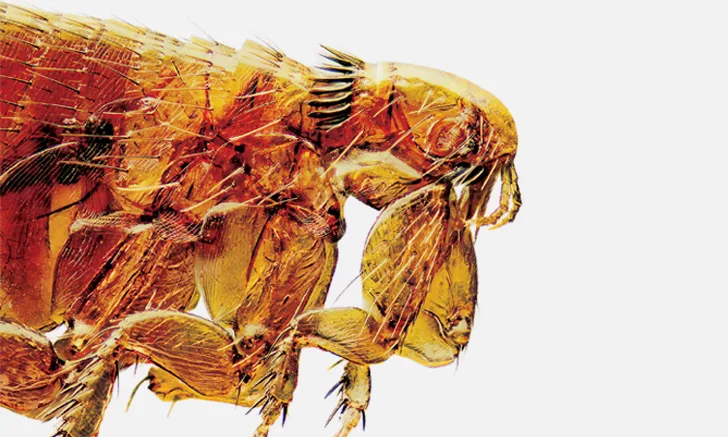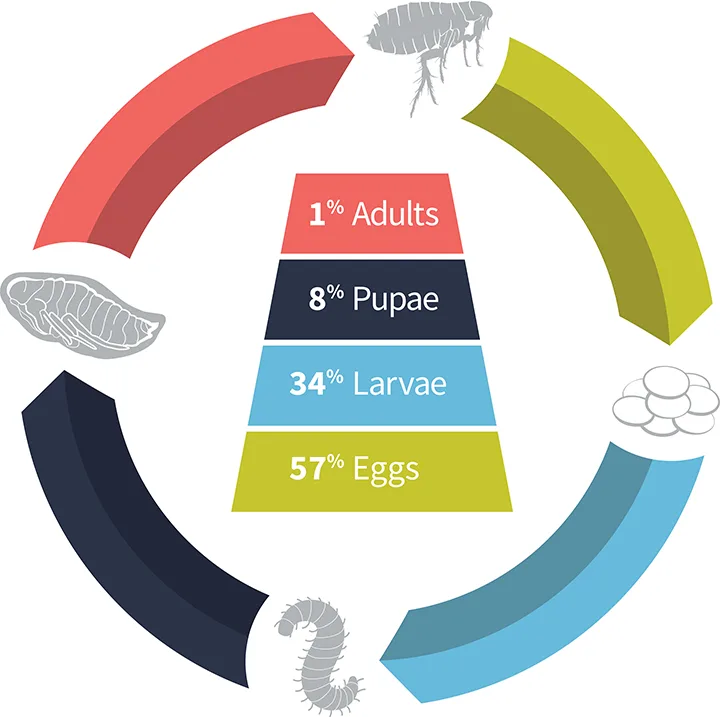This response is incorrect. See below for the correct answer.
The Biting Facts About Fleas
Lynda Paul, LVT, VTS (Clinical Practice–Canine/Feline), CVPP, Nanuet Animal Hospital, Nanuet, New York

This article originally appeared in the May 2017 issue of Veterinary Team Brief.
More than 2200 flea species and subspecies exist throughout the world.1 In North America, Ctenocephalides felis is the most prevalent and is the ectoparasite most commonly found on dogs and cats.1 Thorough knowledge of the flea life cycle, the problems fleas cause pets, and the treatment and prevention options is paramount for veterinary team members and for clients. Understanding the flea life cycle is particularly important when formulating an effective flea-control plan.1
Every veterinary team member should know the following facts about C felis.
The Life Cycle
The flea life cycle is complete within 2 to 8 weeks, depending on the environment; 95oF with 70% humidity is ideal.1,2 Prolonged exposure to low humidity (eg, <50%) or extreme temperatures (eg, >95oF or <35oF) will kill flea larvae.2,3
Adult fleas remain on the host, but the small (0.05 mm), translucent eggs drop off into the environment, where they hatch in 1 to 6 days and then move about feeding on environmental debris and adult flea feces. This larval stage lasts 2 to 3 weeks, depending on food sources and climate. Both eggs and larvae can be seen in the environment without magnification.1
Mature larvae in the environment produce a cocoon in which they pupate and develop into adult fleas. Adults typically emerge in 1 to 2 weeks when they feel the vibrations, carbon dioxide, and heat generated by a suitable host. In temperate climates, 90% to 95% of fleas will hatch within 21 to 35 days, whereas 96% to 99% will hatch within 14 to 28 days in subtropical climates.4

Fleas exist in the environment in many forms.2
Pre-emerged adult fleas (ie, pupae) can survive up to 210 days in the cocoon, protected from most insecticides.3 Insecticides containing dinotefuran and pyriproxyfen will have some effect on the cocoon as well as the eggs,1 but eradication is primarily geared toward killing adult fleas.
Newly emerged fleas can survive 12 days in a moist environment and about 3 days in a drier environment before requiring a blood meal.3 Mating and egg production begin 24 to 48 hours after the first blood meal.2 Females can lay 40 to 50 eggs per day.1,2
Health Concerns for Pets
Flea infestations can cause much more than itching. Flea bite dermatitis or flea allergy dermatitis (FAD) is the most common dermatologic condition in dogs and cats.1 Affected animals are hypersensitive to flea saliva antigens, and 61% of dogs with FAD develop signs between 1 and 3 years of age.1,2
Dogs with FAD exhibit more extreme symptoms than those who are not allergic and may often have secondary yeast and bacterial infections.2 Those suffering from FAD may have intense pruritus and are often restless and constantly licking, scratching, and biting at their skin.3 Patients with FAD present with pruritic papular dermatitis and/or moist dermatitis. Cats often present with self-induced alopecia and eosinophilic granuloma complex from intense, nonstop licking.2,5 In dogs, repeated exposure to flea saliva antigen may cause type I (ie, immediate) or type IV (ie, delayed, cell-mediated immunity) hypersensitivity, or late-phase IgE-mediated reactions.5
Atopic patients are at greater risk for developing hypersensitivity.6,7 Pets with sensitivity can be affected by just a few fleas.7 Nonallergic dogs will have few clinical signs other than occasional scratching.
Fleas can also cause anemia because of excessive blood loss. Puppies and kittens who live outdoors or whose mother goes outdoors regularly are most at risk because they have a limited blood supply and are too young to groom themselves effectively. Elderly outdoor cats are also at risk because they are often debilitated and unable to groom properly, and may suffer from comorbidities.1,3,8,9
Disease Vectors
Fleas are the intermediate host of Dipylidium caninum, a tapeworm. Flea larvae ingest tapeworm eggs, which develop into infective D caninum larvae within the flea and are ingested by the dog or cat. Tapeworm infestation may cause anal irritation, occasional anal sac inflammation, and intestinal obstruction if the worm burden is large.7,10
Domestic cats are reservoirs for Bartonella henselae (ie, bartonellosis or cat scratch fever),11,12 which infected cats may transmit to other cats and to humans when breaks in the skin (eg, scratches, cuts, wounds) are inoculated with flea feces infected with B henselae bacteria.11
Cats may have fever, lymphadenopathy, and lethargy but are often asymptomatic.13 Humans may exhibit low-grade fever, regional lymphadenopathy, and general malaise. Immunocompromised people may show more severe signs.11,13 Controlling fleas is vital to controlling B henselae.12
Fleas are also vectors of hemotropic mycoplasmosis, rickettsiosis, plague, and tularemia.1,14
Treatment & Prevention
Many agents are available for treating and preventing flea infestation, including oral pills and chews, topical applications, and various collars. Products can be a single agent or combination of agents, and may treat or control other ectoparasites as well as fleas.
Products may contain an adulticide that will kill adult fleas, an insect growth regulator that inhibits juvenile fleas from molting into adults, an insect development inhibitor that prevents fleas from forming a proper exoskeleton, or a combination of agents.1
The product recommended will vary according to the veterinarian, owner preference, and the patients individual needs (ie, tick or intestinal parasite prevention). Many over-the-counter formulations contain permethrin (a synthetic pyrethroid) and pyrethrins, which are toxic to cats and should never be used in feline patients.14
Team members must know that many products safe for dogs are not safe for cats, and that all label directions must be followed carefully.15
Myth vs Fact: Client Conversations
Veterinary team members hear many myths about fleas from clients. Here are some common myths, with facts team members can use to educate clients.
My house has no carpet, so I do not have to worry about fleas in my home.
Fact: Flea eggs will drop off the pet and accumulate in the cracks of hardwood floors and along the baseboards. The larvae will then move deep into these crevices to avoid exposure to light.3 Fleas can survive and multiply in most environments.
I do not see fleas on my pet, so there must not be any.
Fact: Visible adult fleas are only a small portion of the infestation. Fleas exist in the environment as ≈57% eggs, 34% larvae, 8% pupae, and 1% adults.2 (See Figure 1.) Fleas are difficult to see on many types of hair coats.7 They can be harder to see on cats, who are very good at removing the fleas when they groom.1
My pet never leaves my yard, and my lawn is short and well maintained.
Fact: Fleas will survive in any shady, moist environment where pets rest.1,4
I do not need to use preventives during the winter months.
Fact: Fleas can survive for 10 days at 37.4°F.4 In cold climates, adult fleas survive on the warm bodies of dogs, cats, and other mammals, and indoors within pupal casings as pre-emerged adults.4
I give my dog garlic as a natural flea preventive.
Fact: Garlic ingestion is an ineffective flea remedy that can have negative health effects. Garlic toxicity can result in oxidative damage to erythrocytes, which may lead to Heinz body formation, hemolytic anemia, methemoglobinemia, and impaired oxygen transportation.6
Example Flea Treatment & Prevention Plan
Missy, a 10-year-old, spayed female rottweiler, presented for itchy skin with areas of alopecia and erythematous skin primarily on her back, flanks, and rear legs.
EXAMINATION
Numerous fleas could readily be seen moving about on Missy's skin.
ENVIRONMENT
Missy lived indoors with her owner, but did go for walks and spend time outside on the lawn. They lived in a Lyme-endemic area, so ticks were also a concern.
TREATMENT PLAN
Oral fluralaner was chosen for its speed of flea kill (ie, the kill starts within 2 hours and >98% of fleas are killed within 12 hours), action duration (12 weeks),17 and ease of use, which helps ensure owner compliance for the entire treatment period. Fluralaner is also effective against ticks.
An initial treatment regimen of 2 doses of fluralaner over 6 months was prescribed to ensure all fleas were eradicated.
The owner was advised that continued treatment would be essential to keep Missy flea-free.
The owner was advised to repeatedly wash all bedding materials in the hottest water possible and to vacuum the entire house, including furniture, throughout the treatment period to help rid the environment of flea eggs and larvae.
OTHER PETS
Any other animals living in the home, even those that did not go outdoors, must be treated because they will also be infested by newly emerged fleas.
PREVENTION
The veterinary nurse, who is usually instrumental in forming an effective flea-control regimen, should be able to discuss the treatment options for each household pet and ways to control fleas in their environment.
EDUCATION
Pets with fleas can be frustrating for clients, and helping them understand the flea life cycle and the need for prolonged treatment, together with effective communication and support, is an essential part of a successful treatment plan.
Examination Room Tip: Demonstrate flea dirt (ie, adult flea feces) to clients by placing combed hair from their pet on a white paper towel that is wet. The flea dirt will leave red streaks when smeared.7,16
Take Action
Hold training sessions that include role play to ensure every team member knows all the facts—and myths—about fleas and can converse knowledgeably with clients.
Be aware that many products safe for dogs are not safe for cats, and always stress the importance of following label directions.
Conclusion
Treatment must continue long enough to break the cycle of flea infestation by disrupting the flea life cycle. Flea infestations are rarely a one-time occurrence, so maintaining a routine preventive plan is recommended.
All veterinary team members should be familiar with the protocols and preventives recommended at their practice, not only to ensure effective patient treatment but also to provide detailed client education and dispel the many myths about fleas.